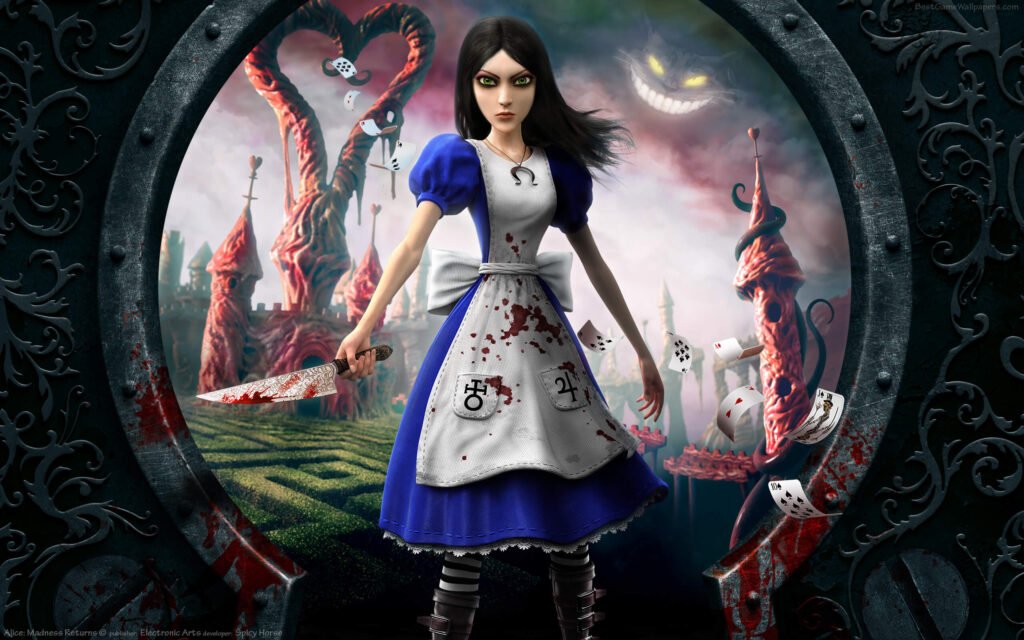Reviewing Alice: Madness Returns almost feels like a rite of passage for me. You see, I’m from the same town as the childhood home of Charles Dodgson, better known to you and I by his pen-name, Lewis Carroll. As such, he’s a bit of a local culture icon.
Very much a proud, passionate, and popular eccentric, Dodgson had an unusual relationship with young girls, who he considered his muses for his writings and art. He would even photograph them in various stages of undress in an effort to capture their Victorian beauty and innocence.
We’ll never know Dodgson’s real desires regarding his young muses, whether he thought of them as the daughter he never had, tools for his creations, or something awkwardly darker. What we do know, is that one of these girls managed to pull at his heartstrings considerably more than the others, the second daughter of the Dean of Oxford University. Her name; Alice Liddell.
While Dodgson and Alice drifted apart as she entered adolescence, the fictional version of Alice became the centre of Dodgson’s imaginary universe. Without his muse, Dodgson would throw himself into his career in mathematics instead, leaving the saga of Alice in Wonderland in the hands of his many successors.
On This Page
Introduction
Wonderland has been explored by many writers over the last 150 years, with some describing it as the fever dream of a dying protagonist or some form of colourful purgatory for the dead, while Alice herself has been everything from a curious, blonde primary-schooler, a runaway bride or, on more than one occasion, a sexually frustrated teen.
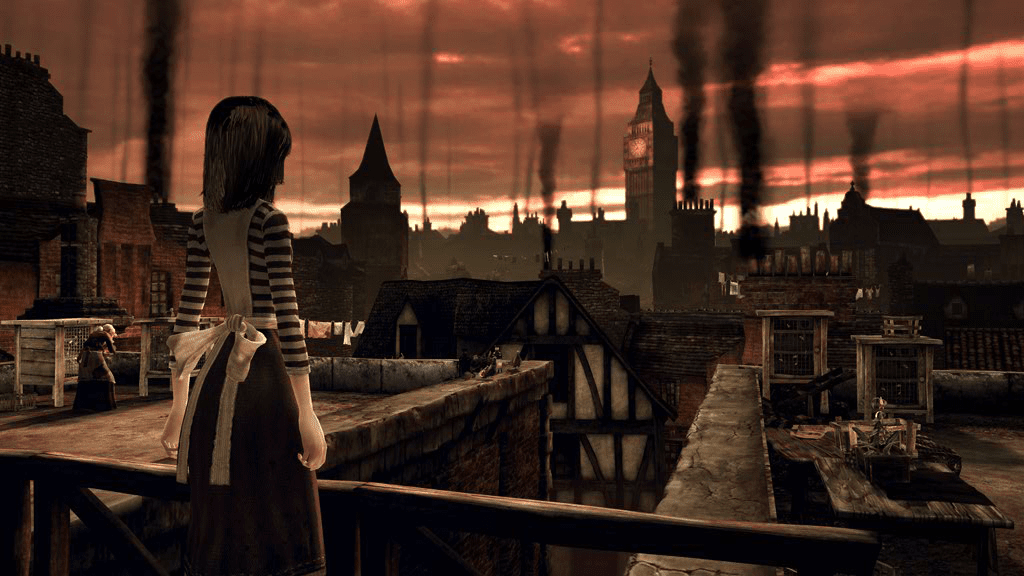
American McGee, of id Software fame, handles this iteration, and his inspirations are clear. McGee takes the darker side of Lewis Carroll and blends it with the art style of Todd McFarlane (Spawn, Twisted Oz). McGee is also influenced (and later influences) the works of Tim Burton (Beetlejuice, Edward Scissorhands).
This version of Wonderland is told as the creation of an imaginative child, a fantasy which only becomes more real as Alice grows and matures, yet this is also a side effect of her deteriorating mental health. As the fantasy grows, so too does the insanity.
Alice: Madness Returns is a 2011 action-adventure game developed by Spicy Horse and released by Electronic Arts for PlayStation 3, Xbox 360, and Windows. The game is the sequel to American McGee’s Alice (2000), itself written as a dark sequel to Alice Through the Looking Glass, replicating many of its events in a rebooted Wonderland.
Story
In the first game, the young Alice Liddell witnesses the deaths of her parents and sister in a tragic house fire, resulting in her having a mental breakdown from the trauma. While held at Rutledge Asylum for treatment, Alice escapes into a twisted version of Wonderland. There, she is forced to battle and defeat the tyrannical Queen of Hearts, which helps Alice overcome her survivor’s guilt and regain some semblance of sanity.
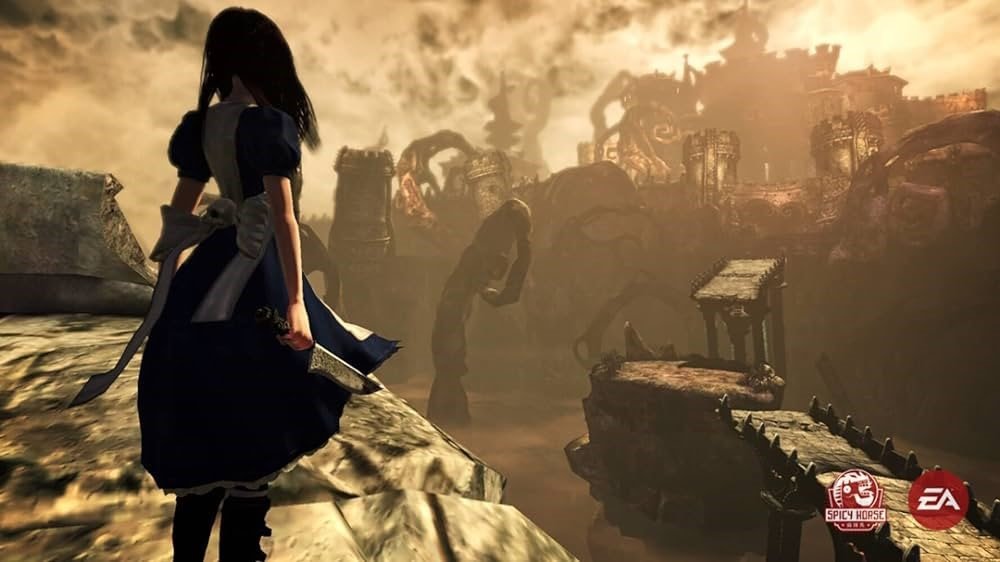
At 18 and legally an adult, Alice is discharged from Rutledge Asylum and alone on the streets. With the help of an old family friend, Alice finds a job at an orphanage in London, caring for troubled children much like herself, under the guidance of psychiatrist Dr. Angus Bumby.
Madness Returns takes place in 1875. Alice, now 19 years old, runs errands for the orphanage. In addition to her lodgings, Alice also receives regular counselling sessions with Dr. Bumby, who uses hypnosis to help his patients forget their traumatic memories. Though she believes that she’s fine, Alice still suffers from strange hallucinations of Wonderland.
During one errand, Alice is struck by a hallucination and finds herself in Wonderland again. Though initially idyllic, the peaceful land quickly becomes corrupted by an entity called the Infernal Train that rampages through it, leaving behind the Ruin, a force that destroys Wonderland’s flora and fauna, and restricts Alice’s access.
Alice meets with the Cheshire Cat who affirms that it is some unknown, outside force causing this corruption, and urges her to seek out former friends and enemies to discover the source of the Train.
Throughout the rest of the game, Alice briefly returns to reality between episodes occurring within Wonderland.
To get rid of the corruption and save Wonderland, Alice will have to stop the cause of the Infernal Train, but in doing so, she’ll need to venture into the very depths of Wonderland where she’ll find her most repressed memories and learn the truth about what really happened on the day of the fire that killed her family. She must be mad, but then, all the best people are.
Gameplay
Alice: Madness Returns is played from a third-person perspective. The player controls Alice for the entirety of the game, running, jumping, exploring dodging, attacking, and even shrinking when required. In combat, Alice gains a small arsenal of weapons which can be utilised in several ways. Her primary weapon is the famous Vorpal Blade, a decorated kitchen knife. The remainder of her arsenal is somewhat akin to the benign and mundane items that take on deadly qualities within Alice’s twisted mind.
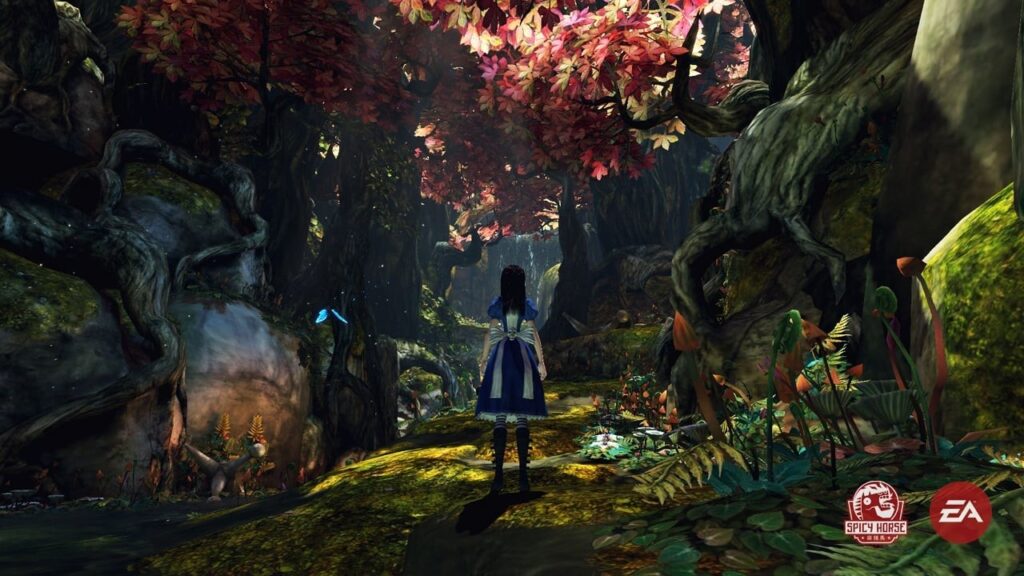
The Pepper Grinder becomes a crank operated gatling gun, used to attack rapidly at a distance, while the Hobby Horse is used as a sledgehammer to inflict heavy damage and break barriers and defences. The Teapot Cannon is sure to be a favourite. It fires steaming blobs of tea which explode to cause heavy damage and, like the Hobby Horse, break barriers. By collecting teeth that are dropped by foes or found scattered around the levels, the player can upgrade these items into more powerful versions.
Two other weapons cannot be upgraded, primarily because they are more defensive than offensive; the Umbrella acts as a shield that can be used to deflect incoming projectiles, and the Clockwork Bomb is a time-delayed/remote-controlled rabbit alarm clock that does a minimal amount of damage to enemies, but its usefulness is better illustrated as a decoy, as well as a weight to keep switches temporarily depressed.
Alice’s health is tracked by a number of rose petals. Should Alice’s health fall to zero during gameplay, the player is forced to start at the most recent checkpoint. They can also regenerate health by stepping into giant purple flowers. Falling off platforms into bottomless pits or hazardous liquids don’t damage Alice but will respawn her at a nearby platform.
While working on each level, the player can discover various secrets. A primary mechanic is to use Alice’s shrinking potion to reduce her size, allowing her to walk through small spaces like keyholes, but also reveals invisible platforms and surfaces; after returning to normal size, these platforms slowly fade back to invisibility, requiring the player to remember their location.
Pig snouts, which make a noise when the player is close, can be struck with the Pepper Grinder to reveal new paths. Radula rooms provide a short challenge to the player, which on completion grants a jar of paint. Obtaining four jars of paint earns the player another rose for Alice’s health. Memories can be picked up that provide voiceovers revealing parts of the backstory.
Graphics/Sound
Alice: Madness Returns is a gorgeous-looking game. It blows the overly polygonal textures of its predecessor out of the water. Alice, in particular, is especially beautiful. Her appearance throughout the game will constantly evolve to suit the situation, beginning as poor, dishevelled, and wearing little more than rags. In Wonderland, Alice is her perfect self, wearing flowing, slightly coquettish, princess dresses, and has some amazingly lifelike hair physics that causes her hair to dance and sway with each movement.
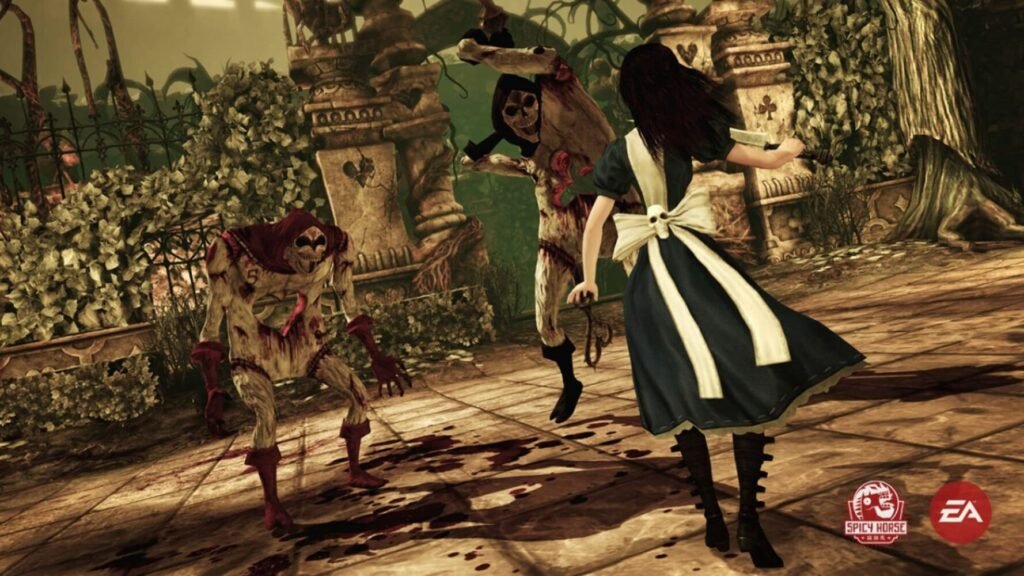
The environments in Wonderland are incredibly vibrant and detailed, which is a contrast to the dark, dreary streets of London that bring back memories of Ripper-era Whitechapel and Les Misérables, and serves as small bridges between chapters. Enemy designs have received a major upgrade from the first game. They’re very interesting and sometimes genuinely frightening. Human NPC characters are surprisingly grotesque too, as Alice sees the monster in everyone.
Wonderland’s lighting is also worth talking about since it’s so pleasing and progressive. As Alice works her way through Wonderland’s themed zones, the game becomes gradually darker, surpassing even London itself, with the aesthetic of the final level being genuinely terrifying. The visage of Madness Returns is one of the driving motivations of the game supporting the narrative. It’s exciting seeing what fantastical environment Alice finds herself in next.
The ample usage of simple, children’s music really helps build the atmosphere of Wonderland, being ironically creepy when it needs to be. Veteran British actress Susie Brann also returns as the voice of Alice and once again does a stellar job of adapting to Alice’s constantly shifting mood.
You’ll need to find every collectible in the game to unlock every trophy, which makes the easier second playthrough a nice addition, though a far simpler option is the ability to backtrack to earlier levels to grab anything you missed the first time around. Trophy hunters will have enough of a challenge finishing the game on ‘nightmare’ difficulty.
The game is entirely linear and so once you’ve missed a collectible, you’ll need to replay the whole level again to find it, which can be a bit of a chore since each level can be a couple of hours long, and feels like an unnecessary barrier for completionists, who would benefit from some form of checkpoint fast-travel system.
Conclusion
McGee has said in interviews that his version of Alice stands out over other interpretations since his Alice develops as a character, and he’s not wrong. Her growth as a person in both games is remarkable. It’s an intricate growth of uneven developments. She matures rapidly and shows great courage and determination, yet also retains her childlike innocence, not unlike a bipolar switch.
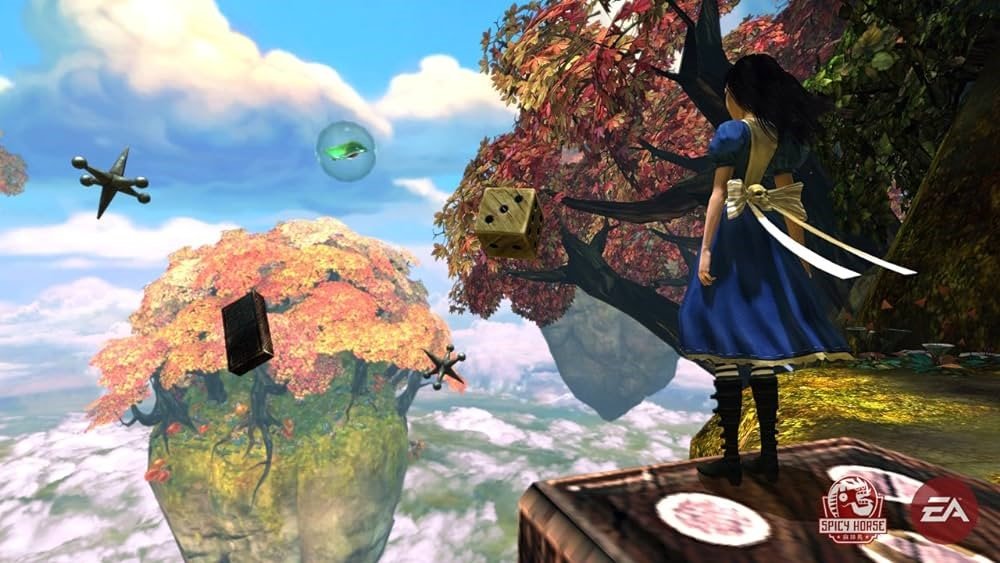
Alice can be reckless, stubborn and becomes enraged when someone says something she disagrees with and will retort verbally. On very rare occasions, Alice uses physical violence when she feels threatened, and will bend the line of what constitutes ‘self-defence’ to breaking point. She is shown to be very ruthless and cynical towards others.
However, Alice is clever, creative, intelligent, and quick-witted with a curious nature. She has a sharp tongue and a direct way of approaching things and is not afraid to speak her mind. Alice inexplicably has a vast vocabulary despite being in a coma for much of her life; she is well-articulated from her parents and Dr. Wilson, and learned a lot of language subconsciously in her coma.
While those around her now see her as a young woman, Alice still sees herself as the child she was before spending years in a catatonic state. She’ll disregard the advances of men and remains stoically asexual throughout her journey, though there is a little touch of vanity in her Wonderland self.
As such, Alice is very much an enigma. She’s unpredictable, even scary at times, particularly when she struggles to differentiate between friend and foe, yet her psychological damage doesn’t make her any less likeable, much like characters like the Scarlet Witch or Wednesday Addams.
It’s not outside the realms of speculation to say McGee’s Alice could be considered a gender-swapped extension of Lewis Carroll himself. Plagued with disturbing thoughts yet capable a greatness when focussed on the task at hand. Someone who can’t quite reach the heights of either heroism or villainy. Something in-between. A perfect example of the antihero.
There is another message here. Alice uses Wonderland, her fantasy and imagination as a coping mechanism to deal with her mental illness; it’s her escapism. In this sense, Wonderland is Alice’s method of catharsis. Despite her cynicism and morbidity, Alice truly wants to set her mind free and restore peace to Wonderland and her own mind. Perhaps imagination and creativity could be our catharsis too.
Alice: Madness Returns is a game that takes the player on a horrifying journey through the darkest parts of the human psyche. However, endure, and you will make it through to the other side. It’s an incredibly enjoyable game despite the horror, because overcoming it is its own reward. It’s fascinating, fulfilling, and fabulous.
Joys
- An incredibly interesting journey through mental illness
- Stunningly eerie and atmospheric
- Fantastic character growth
Cons
- Levels a bit too long
- Maybe too scary for those expecting a more light-hearted adventure
